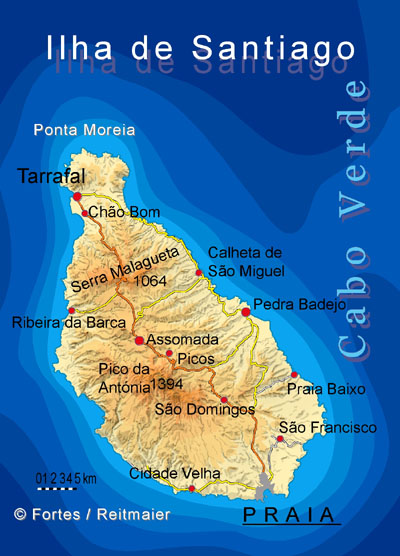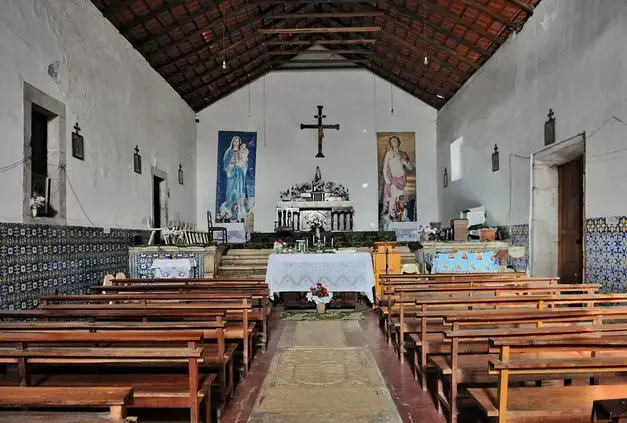Capital: Praia
Currency: Cape Verdean escudo (CVE). July, 2021 – 1CAD=74.39 CVE
Population: 546,000
Language. Portuguese. Cape Verdean Creole – 90-95% from Portuguese and the rest West African languages. Young urban people speak English.
Country Code: +238
SEE

On July 19, 2021, I flew from the Azores (Azores Airlines, 3.5 hours, 206€) arriving at 11 am. We had to show a negative COVID test (I had one when I took the ferry from Terceira to Pico on July 16. I had previously registered (30€) and was given a registration number to give to immigration but they ignored it.
CV is the complete opposite of verdant green Azores – it is very arid and completely brown from the air with minimal green patches in valleys. The dominant tree appears to be acacia.
I met a young German, a recently graduated MD, at the airport, we shared a taxi into town (10€), drank beer and walked around all day. CV is a very African country. Today I saw no Caucasians all day except on the plane (about 10 of the 300 passengers).
SOLAVENTO ISLANDS (São Tiago, Fogo – Praia)
SANTIAGO. The first island settled in Cape Verde. It holds the current capital Praia, the original capital Cidade Velha, and the bulk of the nation’s population.

PRAIA Capital.
Centre Historique de Praia. Tentative WHS (15/03/2016). Most of the plateau area is included in the historic centre. Many newer buildings and little interesting architecture. One walking street has most of the bars and restaurants.
Archaeology Museum (Archivo Nacional de Cabo Verde). Consisting of one room with about 12 glass display cases. A few interesting artifacts, most recovered from ships that sank around CV. 100 escudo.
Ethnography Museum Praia. Has the usual – clothes, household goods, and agricultural materials. 100 escudo.
Sala-Museu Amilcar Cabral. (Fundacao Amilcar Cabral) House Museum. Cabral was born in Guinea Bissau to CV parents and was instrumental in the war of independence between Portugal and its African colonies (Mozambique, Angola, Guinea Bissau and Capo Verde) which he organized in the last three. He was also instrumental in setting up the education system in CV starting in 1974. There is a long video in 4 parts projected on a table (it got very long) but most of his life is described by a series of photos. His wool cap is one of the few actual artifacts of his life. 200 escudo
Pro-Cathedral of Our Lady of Grace (Igreja Nossa Senhora da Graca). Rather plain inside, it is mostly white with no gilt. Simple pews.
Farol de D. Maria Pia. This tall white lighthouse sits on the end of the spit forming the east border of the harbour.
Sucupira Market. This large market sits in the middle of the plateau. It may be one of the busiest markets I have been with an amazing selection of vegetables and fruit. No refrigeration so no meat or cheese. There are several food bars in the centre.
Monumento de Diogo Gomes. Behind the Presidential Palace, is this obelisk on a nice mirador. Diogo Gomes (c. 1420 – c. 1500) was a Portuguese navigator, explorer and writer, a servant and explorer of Portuguese prince Henry the Navigator.
Circa 1456, Gomes was sent out by Prince Henry in command of three vessels down the West African coast. Gomes is said to have reached as far as Rio Grande (now Geba River, in Guinea Bissau), a huge leap beyond the last point known to be reached by the Portuguese. But strong currents checked Gomes’ course and his officers and men feared that they were approaching the extremity of the ocean, so he turned back. On his return, Gomes put in at the Gambia River and ascended the Gambia a considerable distance, some 50 leagues (250 miles), reaching as far as the major market town of Cantor, an entrepot of the Mali gold trade. Gomes credits himself as the first Portuguese captain to interact peacefully with the natives in this region (all prior expeditions had been fended off or fallen in hostilities on the Senegambian coast, although Alvise Cadamosto had also sailed successfully that same year). At Cantor, Gomes collected much information about the gold mines and trade patterns of the upper Senegal and upper Niger, of the cities of Kukia and Timbuktu and the Trans-Saharan trade routes that stretched to the Moroccan coast.
Gomes made another African voyage in 1462. He sailed down to the Saloum River delta in Senegal. On the return, Gomes sailed to the Cape Verde islands and claims to have been the first to land on and name Santiago island.
Monumento ao emigrante. At the Praia International Airport, this reinforced concrete “stela” sits in the middle of the roundabout in front of the terminal.
CIDADE VELHA.
Santiago island was discovered by the Portuguese in 1460 and soon after – in 1466 – there was established the first town, which was then named Ribeira Grande (now – Cidade Velha). There were no native people in Cabo Verde. Ribeira Grande was the first European outpost in the tropics, a vague beginning of the dominance of Western civilization.
In a short time, this picturesque town at the mouth of a 100 m deep canyon turned into a hub of Portuguese colonial business. Ribeira Grande was the main stopover site for Portuguese in their way to their African, South American and Asian colonies. This town served as a transfer point for slaves, nearby were cultivated new (for Europeans) plants from the other colonies. The town became very rich and from time to time was attacked by pirates, e.g. in 1585.
In 1493 here was built the first Christian chapel in sub-Saharan Africa, in 1495 it was extended to its current size. This building was built in Manueline Gothic style, it was austere and simple, both outside and inside.
It is interesting to note that many Africans became influential and revered people in this town. For Europeans of those times it was unusual to see that pastors in Nossa Senhora do Rosario church were pitch black… and, well, they were learned, devoted, optimistic and musically endowed people, much better pastors than most of their European colleagues.
Due to geopolitical changes, the importance of Cabo Verde decreased in the 18th century. Ribeira Grande turned into a sleepy outpost in faraway islands. By the late 18th century capital of the islands was transferred to nearby Praia, many buildings in the old town (Cidade Velha – hence its current name) were destroyed.
Part of its values though were well preserved – original street network, impressive fortress, central square – Pillory Square, and two churches, including the old Nossa Senhora do Rosario church.
Only by the end of the 20th century did the town (now – rather a village) gradually revived. Step by step its most valuable buildings have been renovated and now this is a pleasant, charming colonial town in a spectacular natural setting.
About 20 km from Praia along the west coast, we ended up here unexpectedly. We were told the van was going to Tarrafel but it only went here.
Forte Real de São Felipe. All that remains of this fort just above the road are partial walls and an empty interior. Free
Nossa Senhora do Rosário church (Portuguese for Our Lady of the Rosary) is a 15th-century church, the oldest colonial church in the world. The historic centre of Cidade Velha has been a UNESCO World Heritage site since June 2009.
The main part of the church was built in 1495, which makes it the oldest surviving building of Cidade Velha. Its Manueline side chapel is a rare example of Gothic architecture in Sub-Saharan Africa. The church has been heavily restored but the original architecture and details of Nossa Senhora do Rosario church have been exceptionally well preserved. The church is active up to this day, with a mass held every Sunday.


Gothic vaults in Nossa Senhora do Rosário church. Vaults are marked with the sign of the Order of Christ – remaining part of the Knights Templar
Get In
Visa. Most African countries don’t need a visa. Everybody else may obtain a visa on arrival for 30 Euros, paid online during the registration process necessary before arrival.
By plane. Many flights to Europe, Boston, Washington DC, and Fortaleza (Brazil).
TAP from Lisbon. Azores Airlines from Ponta Delgada, Azores.
Connect via Lisbon or Ponta Delgado (cheapest) to Madeira.
Get Around
By plane. TACV Cabo Verde Airlines no longer exists. Bestfly (an Angolan airline) provides most of the interisland flights. Seats can only be booked by travel agencies in CV, not online.
By boat. There are ferry services between the islands. Flying is significantly shorter but also significantly more expensive.
By bus. 15-passenger Toyota vans travel between rural destinations. They don’t depart till full and have many stops. They appear to provide a huge service to the towns delivering packages and groceries.
Aluguers, open-back pickup trucks with bench seats are particularly on Santo Antão.
Travelling around CV was very difficult. Cape Verde Airlines no longer flies and air service is supplied by Bestfly – bookings can only be made at tour agencies. There were no flights with space for 3 days after my arrival. Ferries are still running.
Sao Vincente, my destination had the worst covid stats in the country and was locked down with virtually no businesses open. Going between any island requires a rapid antigen test. So unfortunately, I decided to leave CV prematurely, partly encouraged by an incredible Azores Airline flight deal – US$203 to Madeira via Porto Delgado, 9 hours departing at 11:55 and arriving in Funchal at 23:55 (much cheaper than the US$600+ flights on TAP via Lisbon, all much longer trips).
I obtained a covid PCR necessary to transit Porto Delgado Airport (6500 CVE , ~59€). I went down to a health agency the next morning and obtained a paper copy as none was sent to my email or text. Madeira does not require a test with a full vaccination.
I rented a scooter to tour Madeira.
NOMAD MANIA Cabo Verde
Experiences
Tabanka. Is a musical genre of Cape Verdean music. In its traditional form, a singer mainly chants a verse that is repeated in unison by other singers. It is rhythmically done with drums and other instruments including whistlers and conches. Rhythmically there are four variants of tabanca.
Along with funaná and batuque, tabanka was a symbol for the struggle for Cape Verdean independence.
Taste cachupa. is a famous dish from Cape Verde – a slow-cooked stew of corn (hominy), beans, cassava, sweet potato, fish or meat (sausage, beef, goat or chicken), and often morcela (blood sausage). Referred to as the country’s national dish, each island has its own regional variation. The version of the recipe called cachupa rica tends to have more ingredients than the simpler, cachupa pobre.
